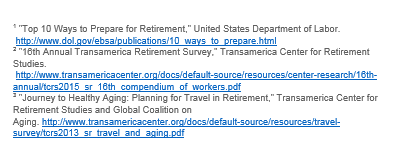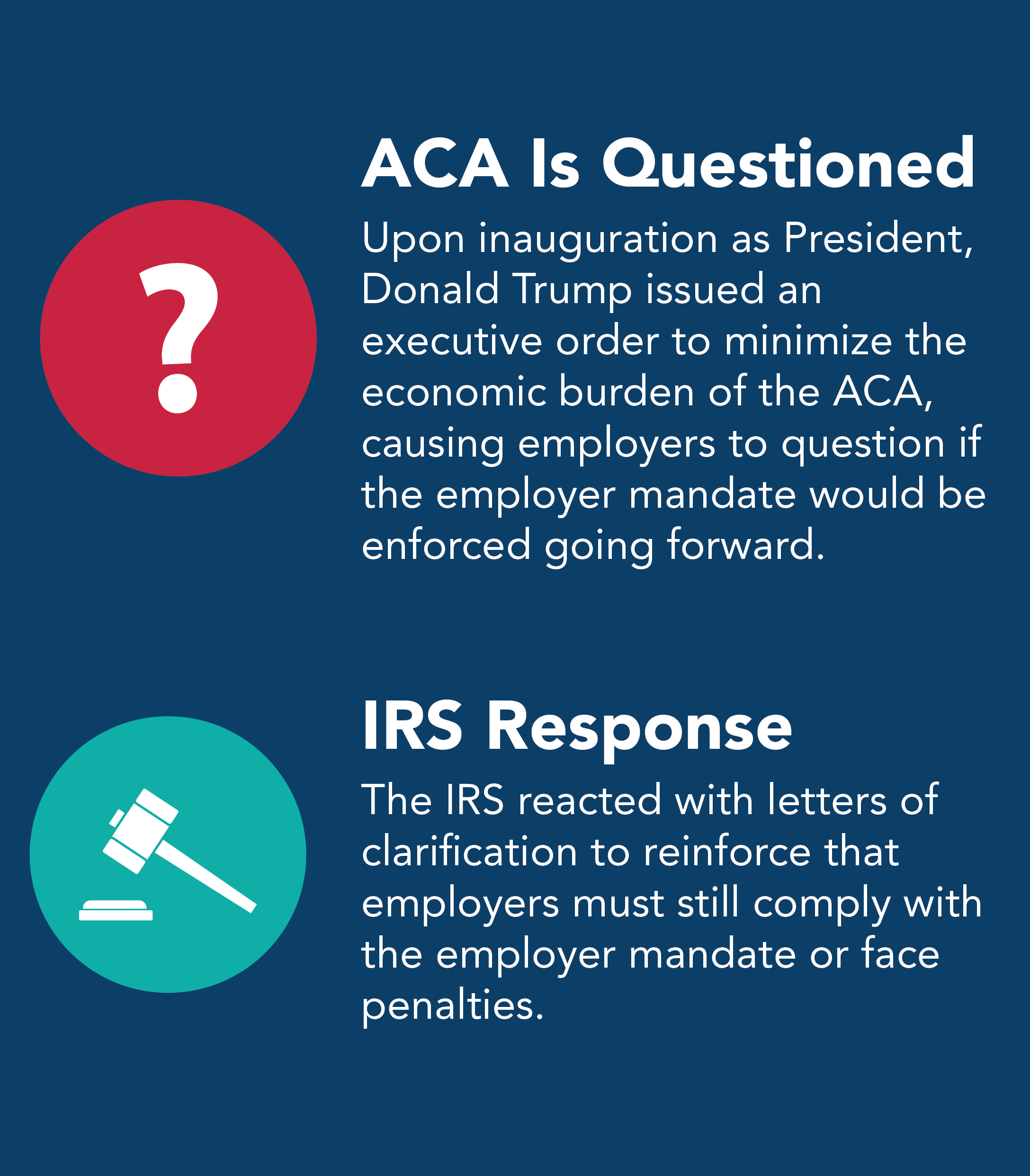Posted on October 17, 2017

The average American spends 20 years in retirement¹
That’s a long time! Make sure you’re ready by saving now for the retirement you’re envisioning.
Waiting to contribute could cost you
What difference could 10 years make? Over $250,000. If at age 25, you started with a $1,000 investment earning 10% annually and contributed $100 a month, you will have earned a total of $415,466 by age 60. If you waited ten years to start saving at age 35, you would only earn $145,846 by your 60th birthday.
Baby Boomers and Millennials contribute the most
According to the 16th Annual Transamerica Retirement Survey conducted by the Transamerica Center for Retirement Studies, Baby Boomers (those born between 1945 and 1964) and Millennials (those born between 1980 and 2000) contribute 8 percent of their annual pay, while Generation X (those born between 1965 and 1980) only contributes 7 percent.²
Prepare to hit the open highway
TransAmerica Center for Retirement Studies and the Global Coalition on Aging found that, despite travel ranking as one of the top dreams for life after retirement, only two in every ten Americans have actually factored this dream into their retirement savings strategy.³ Want to take that trip to Europe? You can! Don’t just dream about it. Make it a part of your retirement goal and be sure your luggage is packed for those golden years.

Posted on October 15, 2017

 Comprehensive healthcare reform legislation was signed into law by President Barack Obama on March 23, 2010. Known as the Patient Protection and Affordable Care Act, it was nicknamed the ACA or Obamacare. The ACA stipulates “employer shared responsibility rules” which require applicable large employers (ALEs) to offer affordable, minimum value health insurance coverage to their full-time employees or pay a penalty. These rules apply to employers with at least 50 full-time employees during the preceding calendar year. The employer shared responsibility rules are also known as the “employer mandate” or the “pay or play” rules. An “ALE” may be penalized if one or more full-time employees obtain a subsidy through the healthcare exchange because the employer did not offer health coverage, or the coverage offered is not affordable or does not provide minimum value.
Comprehensive healthcare reform legislation was signed into law by President Barack Obama on March 23, 2010. Known as the Patient Protection and Affordable Care Act, it was nicknamed the ACA or Obamacare. The ACA stipulates “employer shared responsibility rules” which require applicable large employers (ALEs) to offer affordable, minimum value health insurance coverage to their full-time employees or pay a penalty. These rules apply to employers with at least 50 full-time employees during the preceding calendar year. The employer shared responsibility rules are also known as the “employer mandate” or the “pay or play” rules. An “ALE” may be penalized if one or more full-time employees obtain a subsidy through the healthcare exchange because the employer did not offer health coverage, or the coverage offered is not affordable or does not provide minimum value.
The ACA Is Questioned
Upon his inauguration as President on January 20, 2017, Donald Trump signed an executive order to minimize the economic burden of the ACA until the law can be repealed and replaced. The order did not provide specific guidance related to any particular provision or requirement of the ACA, and appeared to be more of a mission statement for the President’s administration going forward. Further, only Congress is authorized to make changes to the ACA, i.e. through the legislative process. The President is not empowered to alter legislation. Nevertheless, business owners took notice of this executive order and began to wonder if the employer mandate would go away, along with any associated penalties.
The IRS Responds
The President’s executive order created confusion when it directed the Department of Health and Human Services and other federal agencies to “waive, delay, or grant exemptions from ACA requirements that may impose a financial burden”. In response, the Office of Chief Counsel within the IRS issued Letter numbers 2017-0010 and 2017-0013 on April 14, 2017, to clarify the impact (or lack of impact) of the executive order on the employer mandate rule. These letters confirmed that the pay or play rules continue to apply. Taxpayers must still adhere to the ACA requirements, including paying any penalties they may owe.
Where Do We Stand?
For the time being, it’s business as usual. Although both houses of Congress challenged the ACA between May and September 2017, all efforts failed to repeal and replace the law. The result is that the ACA is still in effect until the Senate and/or House, both Republican-led, can craft a viable alternative that will garner sufficient votes to proceed to the President’s desk for signature. In the meantime, ALEs must continue to comply with the employer shared responsibility rule as well as any other reporting requirements.
In fact, The ACA Times has reported that “all signs point to the IRS being prepared to enforce the employer shared responsibility mandate of the ACA”. The website suggests that by December 2017, “the IRS could be sending enforcement notices to inform businesses with 50 or more employees what they owe for failing to comply with the employer shared responsibility mandate”. These notices will serve to enforce the ACA compliance mandate starting with the 2015 tax year. The IRS website does not contradict this opinion and provides a lengthy Q&A dedicated to the employer shared responsibility provisions under the ACA, including information on how employers will be notified of any penalties assessed and how payments will be collected. Now that the myth of the employer mandate waiver has been dispelled, employers would be wise to ensure they have filed all necessary documentation with the IRS to minimize any potential penalties, and then revisit the status of their health insurance offerings and prepare to be ACA compliant, to avoid possible penalties in future tax years.
Where Can Employers Find Help?
MidAmerica’s TotalCare product, offered in conjunction with MyBenefitsChannel, is not just ACA compliance software, but a total ACA consulting service. It enables schools, government, and mid to large employers to reduce potential liability and internal ACA compliance workload, while keeping clients audit-ready. For a low Per Employee Per Month (PEPM) fee, the employer will receive a “Do It For You” (DIFY) solution that:
- Ensures 95% certainty of compliance
- Automatically rolls data into IRS reporting
- Auto generates required notices
- Tracks for audit preparation
- Provides optional audit management
- Is accessible via a mobile application
Despite a series of attempts to repeal the Affordable Care Act, the law is still intact. As your benefits compliance experts, MidAmerica will continue to monitor the status of any potential healthcare reform and ensure you are aware of any effects new legislation could have on your clients’ retirement and healthcare benefit plans. We are committed to providing quality benefits solutions to public sector employers while meeting their budget objectives. This commitment drives us to meet changes in the benefits environment with products that will ensure employers are compliant while receiving the best value for their money.
If you would like to learn more about the TotalCare product, please visit https://mymidamerica.com/acatotalcare/.

The fate of the Affordable Care Act, aka ACA or Obamacare, has been uncertain in 2017. Republicans in Congress have been determined to find a suitable replacement, but it has been a struggle. For months now, Republican legislators have taken turns drafting new bills, both in the House of Representatives and in the Senate. Each new version has faced opposition not only from Democrats, but even within the Republican Party.
While pressure mounts, mainly from the President, to put a bill up for vote, the lack of a consensus in our legislative houses is quite evident. A number of key senators have expressed specific requirements and provisions that must be included in a new healthcare law and have vowed to vote against any bill that fails to include their desired provisions. While the debate in Congress continues, we are providing you with an outline that illustrates the sequence of events that has taken place since early May, leading up to the latest developments. Since this situation is very fluid and the news reports seem to change almost daily, a timeline may help to clarify what the stumbling blocks are and why the healthcare issue presents such difficulties.
- On May 4, 2017, the U.S. House of Representatives presented their version of a healthcare bill, known as the American Health Care Act (AHCA). While preserving many aspects of Obamacare, the AHCA presented some clear changes to tax incentives, mandates, and certain public health policies. The House-approved bill was sent to the U.S. Senate for a thorough review.
- The Senate introduced their own rendition of a healthcare bill on June 22, known as the Better Care Reconciliation Act of 2017 (BCRA). The Senate bill immediately lacked enough Republican support to garner the required number of votes.
- In response, the Senate unveiled a revised version of their BCRA on July 13. With hopes of satisfying concerns from both political parties, this new version included the Cruz Amendment* and additional funding for opioid treatment.
- By July 18, the BCRA was still failing to attract enough followers for a vote. Senate Majority Leader Mitch McConnell now focused on swaying senators to vote on a bill that would repeal the ACA within two years, allowing Republicans not only time to write a more thorough and considerate healthcare law, but the time to transition the country to a new healthcare system.
- The President hosted a luncheon on July 19 for GOP senators, urging them to repeal Obamacare, certainly, but preferably to repeal AND replace. He recommended they cancel their August recess and remain in Washington until a reform bill was finalized.
- On July 20, Republican senators reopened negotiations on their BCRA legislation, resulting in a second revision which removed the Cruz Amendment* and retained some tax measures included in the Affordable Care Act. Still failing to attract the 50 Republican votes needed to bring the BCRA to the floor for debate and a vote, Senator McConnell announced there would be no replacement in the coming days, and the Senate would proceed to vote on repealing the ACA with a two-year delay. This latest piece of proposed legislation became known as the Obamacare Repeal Reconciliation Act, a repeal-only bill.
- July 25 and 26 saw marathon debating in the Senate over whether to disassemble Obamacare completely, resulting in the Senate’s rejection of a full ACA repeal without replacement. At this point, Senator McConnell needed to round up 50 Republicans that would back a final bill in some shape or another.
- On July 27, a “skinny repeal” was debated in the Senate. This legislation, also known as the Health Care Freedom Act, would have repealed the individual and employer mandates contained within the ACA, as well as the medical device tax, and cut off funding to Planned Parenthood. With enough support behind the skinny repeal, Senator McConnell would have been able to introduce a repeal and replace bill to a conference committee with the House, where a more comprehensive proposal could then be negotiated with House Republicans.
- In the early morning hours of July 28, the Health Care Freedom Act failed to acquire the necessary number of votes, with Senator John McCain (R-AZ) being one of its most vocal opponents. McCain is now urging his colleagues to send the bill back to committee, listen to feedback from both sides of the aisle, as well as our nation’s governors, and “produce a bill that finally delivers affordable health care for the American people”.
With the failure of this latest bill, it appears that Obamacare will remain in effect for now. However, the President is still hopeful that the Affordable Care Act will be repealed and ultimately replaced. Only time will tell what sort of legislation will be crafted by Congress and presented to the President for signature. As your benefits compliance experts, MidAmerica will continue to monitor the status of healthcare reform and ensure you are aware of any effects new legislation could have on your retirement and healthcare benefit plans.
MidAmerica’s focus is on public sector employers and their ability to provide quality benefits solutions to their employees while meeting their own budget objectives. We provide the guidance, tools, and resources that our clients and partners require in order to effectively administer their retirement and health and welfare plans. We are committed to keeping you informed, and we will provide updates on this topic as they become available.
*The Cruz Amendment, spearheaded by Senator Ted Cruz (R-TX), would allow insurance companies to sell plans that do not meet minimum ACA coverage requirements, provided there is at least one plan offered that will meet coverage requirements.

When you hear the words “retirement planning”, do you experience feelings of excitement, or dread? For most individuals, it’s probably the latter. That’s unfortunate because retirement planning is a financial goal that most of us have to face, and its importance cannot be overstated. When it comes to planning out the financial state of your golden years, you’ll want to make sure you get it right, because there are no “do-overs” in retirement. The outcome may mean independence and financial freedom if you’ve done your homework, or poverty and financial stress if you haven’t.
Much has been written about the basic principles of Retirement Planning 101, such as: Have a Plan, Be Sure to Save Enough, Be Sure to Save Early Enough, and Don’t Rely on Social Security. Let’s focus here on some other pitfalls that you’ll want to avoid falling into:
- Spending instead of rolling over. A very basic rule of financial planning is to never withdraw money saved in a tax-deferred account until after you retire. Unfortunately, many workers who switch jobs early in their careers cash out their 401(k) plans rather than rolling them over to an IRA, meaning they are paying taxes on the money as well as a 10% penalty for being under age 59½. What may seem like a negligible amount of money will actually compound over many years into a significant savings. Cashing out early eliminates this compounding opportunity. You can see for yourself by trying this free compound interest calculator provided by FinancialMentor.com.
- Taking advice from friends and family on how to invest. You trust your friends and family members for advice on many different topics, such as the best new restaurant in town or where to spend your next vacation. But when it comes to money matters, you’re better off consulting with a certified financial planner and registered investment advisor. Not that your friends don’t have your best interests in mind, but they probably aren’t aware of the many tax laws and retirement investment strategies that need to be taken into consideration when handling your personal financial situation. It’s best to leave that to the experts.
- Believing you’ll want to work forever. When you’re in your 40s and 50s, enjoying good health and vitality, it’s easy to predict that you’ll want to continue working into your 70s. However, circumstances can change and health conditions can emerge, causing you to rethink that plan to keep on working. Working part-time or even launching a second career after retirement are great ways to feel productive and engaged, but this earned income should be considered a bonus to your lifestyle, not a necessity. It’s problematic to plan your retirement security on earned income such as this, because you may realize you don’t want to work as long as you once thought you did.
- Ignoring inflation. Costs continue to rise, so the money you have today will buy much less 10 and 20 years from now. It’s important that you take the rate of inflation into account when forecasting your budget and managing the distribution of your retirement assets, to ensure that you calculate a realistic amount of income to sustain you years from now. Try out this inflation calculator, provided by Prudential, to see how inflation will affect your spending dollars over time.
- Starting Social Security too early. Early retirement benefits are available at age 62 but there is a financial bonus for collecting Social Security later rather than sooner. The earlier you begin collecting benefits, the less you can expect to receive. Waiting until you reach the full benefit age – which depends on the year you were born but let’s say age 66 for the sake of argument – will ensure an additional 8% benefit for each year you delay collecting benefits. If you wait until age 70, your benefit will be 32% higher because of that delay. It may be tempting to begin your Social Security benefits early to guarantee a source of income, but it may be wiser to start spending down your retirement savings first, and thereby delay taking Social Security. Of course, this is dependent upon how much of a nest egg you have accumulated.
- Spending too much early in retirement. You have your freedom now to spend your days as you choose, enjoying your hobbies and not having to cram your vacation into a one week window. But here’s a word of caution – your money has to S-T-R-E-T-C-H and you have no way of knowing for how long. When you’re in the early stages of your retirement, any assets still invested have time to continue to grow. Overspending at this time creates two issues – the loss of the money for one thing and the potential returns that money would have garnered over the next 20 years or so. It’s important to consult with a financial planner long before you retire, to formulate a budget that accounts for your projected pension, retirement accounts, and Social Security. And then stick to it.
When it comes to your retirement planning, prepare yourself to face it head on. Become financially educated so you have the confidence to make sensible decisions. Consult with a professional and make a prudent game plan. There is too much at stake to not take this seriously. All the years you worked and saved depend on the decisions you make as you enter this stage of your life. Having the financial skills to make wise choices puts you on the road to the financial security you deserve.

Do you make a lump sum payment upon retirement for your employees’ unused sick leave, vacation pay or other early retirement incentives? If you do, there is a way to increase the value of the benefit for your employees, while saving money for both of you. Instead of disbursing a check, you can implement a Special Pay Plan (SPP) or a Retiree-Only HRA.
A Special Pay Plan is an interest-bearing 401(a)/403(b) retirement account that is set up by you in your employee’s name. You make deposits/contributions into this account in lieu of disbursing a check for your employee’s unused sick leave, separation of service pay or other retirement incentive pay.
Special Pay Plan
The funds deposited into the Special Pay Plan can be invested in a guaranteed fixed interest account, which can be for any expense. How does this help increase the value of the benefit? You and your employee will permanently save 7.65% on FICA taxes. For example, if the benefit amount is $10,000, your employee will take home the entire $10,000 less income tax, saving $765 in FICA. And since you pay FICA on their behalf, you will also save $765 on each employee that receives the benefit.
Funds in a Special Pay Plan will be available at age 55 for retired employees without an early withdrawal penalty. If an employee is at least age 55 at the time of retirement and remains separated from service, they can access the funds prior to age 59 ½ without penalty. This account is tax-deferred, meaning that an employee is not taxed until they withdraw funds. This is beneficial to them because if their tax-bracket is lower after retirement, they could potentially save on tax when they withdraw funds.
Retiree-Only HRA
A Retiree-Only Health Reimbursement Arrangement (HRA) is another way that school, city and county employers can choose to increase the value of the benefit. This is also an interest-bearing, employer-funded account created in the employee’s name. Deposits can be made completely tax-free (not subject to FICA, Federal or State income taxes) so your employees can receive 100% of the value of each benefit dollar.
By using a Retiree-Only HRA, employees would be reimbursed tax-free for their eligible medical expenses and/or premiums including dental and vision. The account balance rolls over each year. Retirees have the flexibility to choose which eligible expenses to submit for reimbursement and when to submit. Upon the retiree’s death, their spouse and any qualifying dependents can use the remaining HRA balance for eligible medical expenses and premiums.
Employers who implement one of these plans should be aware of the potential change in regulations. The IRS has proposed 457(f) regulations which may affect schools’, cities’ and counties’ sick leave and unused vacation payouts at retirement. It is unclear whether these plans would be considered a “bona fide” or a type of non-qualified deferred compensation. If the plans were deemed deferred compensation, employees would be subject to tax liability equal to the value of the unused leave. It has been stated that the final 457(f) regulations will most likely not be out this year but will be released at a later date. Stayed tuned to our blog for updates on this issue.
The proposed 457(f) regulations have been on our minds for the last several months. While a change in regulations seems all but certain, the IRS has now indicated it is highly unlikely the regulations will be finalized this year. The agency has been working to draft an adequate safe harbor for determining whether a leave plan is considered bona fide under the proposed tax-exempt deferred compensation regulations. According to a source within the IRS Office of Associate Chief Counsel, there has been an inability to reach an agreement on the terms of a safe harbor, delaying the ability to finalize the proposed regulations.
The proposed 457(f) changes can pose significant effects on both employers and employees, with additional taxation being perhaps the most noteworthy effect. To recap, IRS Code Section 457(f) provides rules to determine when an arrangement is a deferred compensation plan, and whether that plan qualifies for favorable tax treatment. It also clarifies the definition of a bona fide sick and vacation leave plan.
What’s the Possible Impact?
Many public sector employers offer generous programs that allow employees to exchange unused sick leave and vacation time for cash payout at retirement. If the IRS determines that payouts such as this are considered deferred compensation, both employees and employers would face a tax liability determined by the value of unused leave balances.
So what does this mean for you? Here are some of the major concerns:
- A portion of accrued leave in non-qualified plans may be subject to taxation.
- Employees may lose a valuable benefit, and employers could have difficulty attracting quality talent.
- The administrative, compliance, and staffing burden for HR departments may increase.
- Employees will likely feel compelled to use all of their sick and vacation days, creating an unstable environment in the workplace and HR hurdles.
What Have We Learned?
Fortunately, the same IRS source mentioned above expressed optimism about the guidance that will eventually be dispensed, offering that the IRS does not wish to ban “cash for employee leave” programs. The IRS does appreciate the need for a clear ruling and the organization is earnestly working to finalize an opinion. It is expected they will release guidance on the 457(f) regulations in conjunction with other related guidance, but it may be too ambitious to expect these releases would be made by the end of this year. Rest assured that MidAmerica will continue to monitor the situation, and provide updates on this topic as they become available.
For more information on potential implications of the 457(f) regulations, CLICK HERE to view our webinar.
If you have any questions on how you can prepare for potential regulatory changes, email Trent Teesdale, SVP of Business Development, at [email protected].
Posted on February 28, 2017
Traditionally, public sector employers have generously provided some type of employer-paid health insurance benefit for their early retirees (under age 65) as a way to bridge the gap between early retirement and Medicare eligibility. In a time when health insurance was reasonably affordable, it was common to offer what is known as a “defined benefit” plan, in which an employer promises a specific benefit (such as health insurance) over a specific time period.
The Issue
Unfortunately, with premiums rising and budgets being strained, it may be challenging for schools, cities, and counties to plan effectively for the retirement health benefits awarded to former employees now in retirement, or for the health benefits promised to current employees as they retire. Yearly expenditures to fund these benefits become a tremendous liability, draining budgets and forcing schools to deflect money away from classroom instruction and municipalities to reduce spending on needed services and infrastructure.
The Solution
Employers are now realizing they need to reconsider the benefits packages they offer in an effort to contain costs and long-term financial obligation, yet still provide an impactful retirement benefit to their employees. A Defined Contribution Retirement Plan may be the solution. Contrary to a defined benefit plan which provides a distinct benefit over time, no matter the cost, the defined contribution plan allocates a specific contribution toward that benefit. The contribution is not tied to rising insurance costs, which makes cash flows more predictable, and results in the reduction, or even elimination of, OPEB (Other Post-Employment Benefits) liability.
How a Health Reimbursement Arrangement Can Help
One of the most ideal funding options for a defined contribution plan is a Health Reimbursement Arrangement, or HRA. The HRA account is designed to reimburse employees for their eligible medical expenses to offset their out-of-pocket costs. The employer regularly deposits funds into individual accounts on behalf of employees while they are employed. These funds, with earnings, are free from federal income and FICA taxes, and can be used at any time, upon eligibility. To be eligible to use the funds, the participant must have either separated from service or retired. Participants are 100% vested immediately, meaning that they own the account balance as soon as the account is established.
Migrating an employer’s benefit plan design from a defined benefit to a Defined Contribution HRA will enable that employer to reduce existing liability and minimize future costs, all while keeping its promise to employees and freeing up resources to better serve students, citizens, and the community. A dedicated solutions partner can furnish an HRA plan that will provide a seamless transition for employees entering the retirement phase of their lives, and ensure they receive the most appropriate benefit, even while healthcare costs continue to rise.
Trusts & HRAs
In conjunction with an HRA program, employers may consider establishing a Post-Employment Benefit Trust as a vehicle to pre-fund employee and retirement benefits. A trust enables the employer to set aside funds while the employee is still actively employed in order to minimize, or even eliminate, the liability later on. Funding through a trust reduces what can be a substantial liability on the financial statement. The trust is a legal entity and trust funds are safe from the employer’s creditors. If you’d like to learn how HRAs and trusts can help you achieve your financial goals, contact us today at [email protected].
MidAmerica Administrative & Retirement Solutions has been providing retirement solutions since 1995, and health and welfare programs since 2002. Our goal is to maximize benefit dollars for both the employer and the employees. Our staff of highly experienced subject matter experts, ease of technology, and streamlined administration enable us to reach this goal. Please contact us if you’d like assistance in reaching your goals.




 Comprehensive healthcare reform legislation was signed into law by President Barack Obama on March 23, 2010. Known as the Patient Protection and Affordable Care Act, it was nicknamed the ACA or Obamacare. The ACA stipulates “employer shared responsibility rules” which require applicable large employers (ALEs) to offer affordable, minimum value health insurance coverage to their full-time employees or pay a penalty. These rules apply to employers with at least 50 full-time employees during the preceding calendar year. The employer shared responsibility rules are also known as the “employer mandate” or the “pay or play” rules. An “ALE” may be penalized if one or more full-time employees obtain a subsidy through the healthcare exchange because the employer did not offer health coverage, or the coverage offered is not affordable or does not provide minimum value.
Comprehensive healthcare reform legislation was signed into law by President Barack Obama on March 23, 2010. Known as the Patient Protection and Affordable Care Act, it was nicknamed the ACA or Obamacare. The ACA stipulates “employer shared responsibility rules” which require applicable large employers (ALEs) to offer affordable, minimum value health insurance coverage to their full-time employees or pay a penalty. These rules apply to employers with at least 50 full-time employees during the preceding calendar year. The employer shared responsibility rules are also known as the “employer mandate” or the “pay or play” rules. An “ALE” may be penalized if one or more full-time employees obtain a subsidy through the healthcare exchange because the employer did not offer health coverage, or the coverage offered is not affordable or does not provide minimum value.

